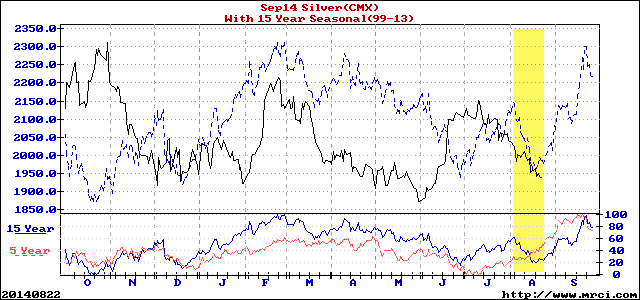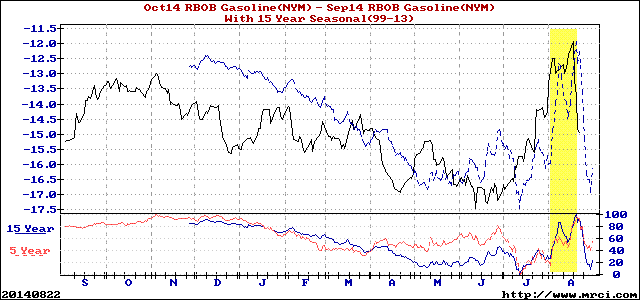I was driving through the countryside of Maryland and Delaware returning from the Beach this weekend and could not help but notice the overabundance of both Corn and Soybean crops growing all along my route home. Both crops were greener than a Beverly Hills Mansion yard. The Corn was standing about 7-8 feet tall and the Soybeans were very leafy. What was of even more interest was the extra land that the farmers were trying to use for these crops. It seemed every square inch of their property in some cases right up to the edge of the highway and their homes was used for planting these crops. Mind you this was only in Maryland and Delaware, hardly the crop producing States of the country.
This is very typical of what happens after a Commodity has a boom year in price as we did in 2012 during the worst drought in 50 years. Everybody saw the high prices of both of these crops and immediately started preparing for the following years and here we are with a bumper crop of Corn and Soybeans expected with this year’s harvest.
This brings me to a Seasonal Intra-Commodity Spread in the Soybean market that has closed higher on October 2 than on August 29 – 93% of the time in the past 15 years. And the best part is that the worst closing drawdown was only 4 cents during 4 of the past “30 years.” Each penny move in Soybeans is worth $50. The average profit over the past 15 years has been $688 per Spread.
Disclaimer: This is not a trade recommendation to buy or sell a Commodity Futures Spread, but merely for educational purposes only.
The Spread involves simultaneously buying the May 2015 Soybean Futures and selling the November 2014 Soybean Futures.
I would like to thank Moore Reasearch (www.mrci.com) for allowing me to use their Seasonal charts for this article. They are still offering a free two week trial for those interested in trading Seasonal Spreads. Just contact Melissa Moore at [email protected]
With the grain markets harvest season just looming a few months ahead it is a good time to be preparing for the outcome of the new crop. Typically the Soybean market gets the majority of the crop harvested in October. This will make the November Futures contract the one that represents the new crop supplies coming to market for 2014. During this time so much grain in brought to market that the Seasonal low price tends to come at the end of October each year when there is the most grain available for delivery.
As Jerry Toepke of MRCI pointed out the Futures markets help avoid dumping all of the supply of Soybeans at harvest and instead ensure and distribute supply over the next year. The way the Futures markets do this is a vehicle called Spreads. Higher prices for deferred delivery help pay storage costs and discourage deferred consumption; lower prices for more immediate delivery discourage immediate selling and encourage more immediate consumption.
As the market comes into the harvest season participants begin building a premium into the deferred Futures contract months. By doing this the Commercials will have an incentive to store some of the Soybeans for future delivery instead of dumping this huge anticipated crop all at once on the cash market making prices crash lower even more than they already are. The higher prices in the deferred months will help cover the carrying charges to store the Soybeans.
Figure 1 is a chart showing the Seasonal window (in yellow) when MRCI has found this Spread to begin a rally.
The black line is this year’s closing price of the Spread so far. The blue line is the 15 year average of what the Spread pattern has typically done. Below that is an overlay of both the 15 and 5 year Spread averages. Notice how both the 15 and the 5 bottom out about the same time. This shows consistency across both longer term and shorter term seasonal patterns.
Fig 2 is a chart of this Spread using Candles to better illustrate the trend and levels we need to trade.
Fig 2 shows how the Spread was in a sideways trading range for several months. Once it broke out of this range and began its Seasonal rally it came back and retested (old resistance becoming support) the top of its old trading range. Once it did this the price created an upward channel that might be useful for helping to find your trading levels in the vicinity before buying this Spread. Looking back at Fig 1 you can see this Spread has moved up nicely and it may need to have a correction back in the lower portion of this up channel before entering the market.
The volatility of this Spread is minimal. The average daily range is approximately 2 cents ($100) compared to the average daily range of a Soybean Futures contract of 21.50 cents ($1,050). The margin required to hold a Spread is approximately $1,000 compared to $3,300 for an outright Soybean Futures contract.
As you can see Spread trading offers a Futures trader a way of entering into a position with reduced risk (lower volatility) and lower initial capital requirements (margin). Spreads are lower risk, not “risk free.” All investments have some form of risk. Along with risk comes potential reward, but we must understand that our analysis of the market must still be done diligently even if we are using Seasonal research from a company like MRCI. When traders try to use Seasonal patterns blindly (buying or selling on optimal dates without doing technical or fundamental analysis) they are subject to extreme equity drawdowns before the trade has a chance to turn profitable in some cases. Using supply (resistance)/demand (support) technical analysis will help increase your odds of timing your entry closer to the end of a correction rather than buying at the highs.
“Courage is not the absence of fear, but rather the judgment that something else is more important than fear.” Ambrose Redmoon
This content is intended to provide educational information only. This information should not be construed as individual or customized legal, tax, financial or investment services. As each individual's situation is unique, a qualified professional should be consulted before making legal, tax, financial and investment decisions. The educational information provided in this article does not comprise any course or a part of any course that may be used as an educational credit for any certification purpose and will not prepare any User to be accredited for any licenses in any industry and will not prepare any User to get a job. Reproduced by permission from OTAcademy.com click here for Terms of Use: https://www.otacademy.com/about/terms
Editors’ Picks
EUR/USD retreats below 1.0700 as USD rebounds

EUR/USD lost its traction and retreated slightly below 1.0700 in the American session, erasing its daily gains in the process. Following a bearish opening, the US Dollar holds its ground and limits the pair's upside ahead of the Fed policy meeting later this week.
USD/JPY recovers toward 157.00 following suspected intervention

USD/JPY recovers ground and trades above 156.50 after sliding to 154.50 on what seemed like a Japanese FX intervention. Later this week, the Federal Reserve's policy decisions and US employment data could trigger the next big action.
Gold holds steady above $2,330 to start the week

Gold fluctuates in a relatively tight channel above $2,330 on Monday. The benchmark 10-year US Treasury bond yield corrects lower and helps XAU/USD limit its losses ahead of this week's key Fed policy meeting.
Week Ahead: Bitcoin could surprise investors this week Premium

Two main macroeconomic events this week could attempt to sway the crypto markets. Bitcoin (BTC), which showed strength last week, has slipped into a short-term consolidation.
Five Fundamentals for the week: Fed fears, Nonfarm Payrolls, Middle East promise an explosive week Premium

Higher inflation is set to push Fed Chair Powell and his colleagues to a hawkish decision. Nonfarm Payrolls are set to rock markets, but the ISM Services PMI released immediately afterward could steal the show.
RECOMMENDED LESSONS
Making money in forex is easy if you know how the bankers trade!
Discover how to make money in forex is easy if you know how the bankers trade!
5 Forex News Events You Need To Know
In the fast moving world of currency markets, it is extremely important for new traders to know the list of important forex news...
Top 10 Chart Patterns Every Trader Should Know
Chart patterns are one of the most effective trading tools for a trader. They are pure price-action, and form on the basis of underlying buying and...
7 Ways to Avoid Forex Scams
The forex industry is recently seeing more and more scams. Here are 7 ways to avoid losing your money in such scams: Forex scams are becoming frequent. Michael Greenberg reports on luxurious expenses, including a submarine bought from the money taken from forex traders. Here’s another report of a forex fraud. So, how can we avoid falling in such forex scams?
What Are the 10 Fatal Mistakes Traders Make
Trading is exciting. Trading is hard. Trading is extremely hard. Some say that it takes more than 10,000 hours to master. Others believe that trading is the way to quick riches. They might be both wrong. What is important to know that no matter how experienced you are, mistakes will be part of the trading process.


